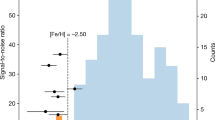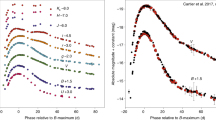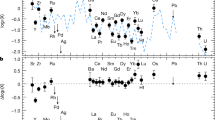Abstract
The most massive globular cluster in the Milky Way, ω Centauri, is thought to be the remaining core of a disrupted dwarf galaxy1,2, as expected within the model of hierarchical merging3,4. It contains several stellar populations having different heavy elemental abundances supplied by supernovae5—a process known as metal enrichment. Although M 22 appears to be similar to ω Cen6, other peculiar globular clusters do not7,8. Therefore ω Cen and M 22 are viewed as exceptional, and the presence of chemical inhomogeneities in other clusters is seen as ‘pollution’ from the intermediate-mass asymptotic-giant-branch stars expected in normal globular clusters9. Here we report Ca abundances for seven globular clusters and compare them to ω Cen. Calcium and other heavy elements can only be supplied through numerous supernovae explosions of massive stars in these stellar systems10, but the gravitational potentials of the present-day clusters cannot preserve most of the ejecta from such explosions11. We conclude that these globular clusters, like ω Cen, are most probably the relics of more massive primeval dwarf galaxies that merged and disrupted to form the proto-Galaxy.
This is a preview of subscription content, access via your institution
Access options
Subscribe to this journal
Receive 51 print issues and online access
$199.00 per year
only $3.90 per issue
Buy this article
- Purchase on Springer Link
- Instant access to full article PDF
Prices may be subject to local taxes which are calculated during checkout



Similar content being viewed by others
References
Lee, Y.-W. et al. Multiple stellar populations in the globular cluster ω Centauri as tracers of a merger event. Nature 402, 55–57 (1999)
Bekki, K. & Freeman, K. C. Formation of ω Centauri from an ancient nucleated dwarf galaxy in the young Galactic disc. Mon. Not. R. Astron. Soc. 346, L11–L15 (2003)
Freeman, K. C. in The Globular Cluster-Galaxy Connection (eds Smith, G. H & Brodie, J. P.) 608–614 (ASP Conf. Ser., Vol. 48, Astronomical Society of the Pacific, 1993)
Diemand, J., Kuhlen, M. & Madau, P. Formation and evolution of galaxy dark matter halos and their substructure. Astrophys. J. 667, 859–877 (2007)
Johnson, C. I. et al. A large sample study of red giants in the globular cluster Omega Centauri (NGC 5139). Astrophys. J. 698, 2048–2065 (2009)
Marino, A. F. et al. A double stellar generation in the globular cluster NGC 6656 (M22). Two stellar groups with different iron and s-process element abundance. Astron. Astrophys. 505, 1099–1113 (2009)
Carretta, E. et al. Properties of second generation stars in globular clusters. Preprint at 〈http://arXiv.org/abs/0811.3591v1〉 (2008)
Georgiev, I. Y. et al. Globular cluster systems in nearby dwarf galaxies II. Nuclear star clusters and their relation to massive Galactic globular clusters. Mon. Not. R. Astron. Soc. 396, 1075–1085 (2009)
Ventura, P. D. et al. Predictions for self-pollution in globular cluster stars. Astrophys. J. 550, L65–L69 (2001)
Timmes, F. X., Woosley, S. E. & Weaver, T. A. Galactic chemical evolution: hydrogen through zinc. Astrophys. J. 98 (Suppl.). 617–658 (1995)
Baumgardt, H., Kroupa, P. & Parmentier, G. The influence of residual gas expulsion on the evolution of the Galactic globular cluster system and the origin of the Population II halo. Mon. Not. R. Astron. Soc. 384, 1231–1241 (2008)
Anthony-Twarog, B. J. et al. Ca II H and K filter photometry on the uvby system. I-The standard system. Astron. J. 101, 1902–1914 (1991)
Zinn, R. The globular cluster system of the Galaxy. I. The metal abundances and reddening of 79 globular clusters from integrated light measurements. Astrophys. J. 42 (Suppl.). 19–40 (1980)
Zinn, R. & West, M. J. The globular cluster system of the Galaxy. III. Measurements of radial velocity and metallicity for 60 clusters and a compilation of metallicities for 121 clusters. Astrophys. J. 55 (Suppl.). 45–66 (1984)
Stetson, P. B. DAOPHOT: A computer program for crowded-field stellar photometry. Publ. Astron. Soc. Pacif. 99, 191–222 (1987)
Stetson, P. B. The center of the core-cusp globular cluster M15: CFHT and HST observations, ALLFRAME reductions. Publ. Astron. Soc. Pacif. 106, 250–280 (1994)
Norris, J. & Freeman, K. C. The chemical inhomogeneity of M22. Astrophys. J. 266, 130–143 (1983)
Richter, P., Hilker, M. & Richtler, T. Strömgren photometry in globular clusters: M55 & M22. Astron. Astrophys. 350, 476–484 (1999)
Anthony-Twarog, B. J., Twarog, B. A. & Craig, J. CN and Ca abundance variations among the giants in M22. Publ. Astron. Soc. Pacif. 107, 32–48 (1995)
Decressin, T., Charbonnel, C. & Meynet, G. Origin of the abundance patterns in Galactic globular clusters: constraints on dynamical and chemical properties of globular clusters. Astron. Astrophys. J. 475, 859–873 (2007)
Yong, D. & Grundahl, F. An abundance analysis of bright giants in the globular cluster NGC1851. Astrophys. J. 672, L29–L32 (2008)
Lee, J.-W. et al. Chemical inhomogeneity in red giant branch stars and RR Lyrae variables in NGC1851: two subpopulations in red giant branch. Astrophys. J. 695, L78–L82 (2009)
Cudworth, K. M. Proper motions, membership, and photometry in the globular cluster M22. Astron. J. 92, 348–357 (1986)
Brown, J. A. & Walllerstein, G. High-resolution CCD spectra of stars in globular clusters. VII. Abundances of 16 elements in 47 Tuc, M4, and M22. Astron. J. 104, 1818–1830 (1992)
Lee, Y.-W., Gim, H. B. & Casetti-Dinescu, D. Kinematic decoupling of globular clusters with the extended horizontal branch. Astrophys. J. 661, L49–L52 (2007)
Piotto, G. et al. Metallicities on the double main sequence of ω Centauri imply large helium enhancement. Astrophys. J. 621, 777–784 (2005)
Pflamm-Altenburg, J. & Kroupa, P. Recurrent gas accretion by massive star clusters, multiple stellar populations and mass threshold for spherical stellar systems. Mon. Not. R. Astron. Soc. 397, 488–494 (2009)
Acknowledgements
J.-W.L. thanks A. Walker for providing the CTIO Ca filter transmission curve, D. Yong for NGC 1851 spectroscopic data before publication, and A. Yushchenko for discussions on spectrum synthesis. Support for this work was provided by the National Research Foundation of Korea to the Astrophysical Research Center for the Structure and Evolution of the Cosmos (ARCSEC). This work was based on observations made with the CTIO 1.0-m telescope, which is operated by the SMARTS consortium.
Author Contributions J.-W.L. performed observations, data analysis, interpretation, model simulations and writing of the manuscript; Y.-W.K. participated in observation planning; and J.L. performed part of the observations and data analysis. Y.-W. L. performed interpretation and writing of the manuscript. All authors discussed the results and commented on the manuscript.
Author information
Authors and Affiliations
Corresponding authors
Supplementary information
Supplementary Information
This file contains Supplementary Notes and Data, Supplementary References, Supplementary Table 1-3 and Supplementary Figures 1-16 with Legends. (PDF 2185 kb)
Rights and permissions
About this article
Cite this article
Lee, JW., Kang, YW., Lee, J. et al. Enrichment by supernovae in globular clusters with multiple populations. Nature 462, 480–482 (2009). https://doi.org/10.1038/nature08565
Received:
Accepted:
Issue Date:
DOI: https://doi.org/10.1038/nature08565
This article is cited by
-
What is a globular cluster? An observational perspective
The Astronomy and Astrophysics Review (2019)
-
The exclusion of a significant range of ages in a massive star cluster
Nature (2014)
-
Photometric evidence of the multiplicity of stellar populations in globular clusters
Astrophysics (2013)
-
Multiple populations in globular clusters
The Astronomy and Astrophysics Review (2012)
-
Assortment in the Galaxy
Nature (2009)
Comments
By submitting a comment you agree to abide by our Terms and Community Guidelines. If you find something abusive or that does not comply with our terms or guidelines please flag it as inappropriate.



